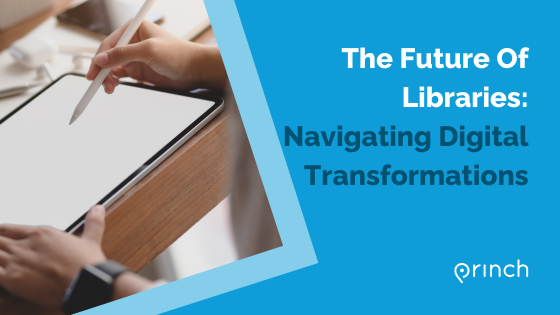In this week’s Princh Library Blog post, guest writer Jill Brooks discusses how libraries can navigate their digital transformation, including some of the challenges libraries face and the tools they can utilize. Enjoy!
Libraries have long stood as bastions of knowledge, evolving through centuries from exclusive archives of scrolls to community hubs bustling with activity and learning. In the digital age, this evolution has accelerated, pushing libraries to navigate the complex waters of digital transformation. With the rise of the internet and digital media, information consumption habits have drastically changed, necessitating a shift in how libraries operate.
The Drive Towards Digital Libraries
The transformation of libraries from their traditional, physical embodiments to digital forms represents a profound shift in the way knowledge and information are curated, accessed, and disseminated. This metamorphosis didn’t occur in the blink of an eye but was a meticulous and deliberate evolution. Initially, it began with the digitization of library catalog systems, which was a monumental step away from the card catalog drawers that required physical browsing. This initial phase set the stage for a broader digital revolution within libraries, paving the way for the introduction of eBooks, online databases, scholarly articles, and multimedia resources, all available through library websites and digital platforms.
The catalyst for this sweeping change was the advent and proliferation of digital technology, which has been a powerful equalizer in terms of access to information. Before the digital era, access to information was often dictated by one’s proximity to physical libraries and the resources they housed. Students, researchers, and the general public had to physically visit a library to access books, journals, or archives. However, with digital libraries, the geographical and socioeconomic barriers that once limited access have been significantly eroded. Now, anyone with internet access can tap into digital libraries’ vast repositories of knowledge, which house millions of digital books, articles, and other resources.
This democratization of access is a pivotal development in the history of libraries and information access. Digital libraries extend their services beyond their physical walls, offering 24/7 access to users across the globe. This capability has transformed libraries from static repositories of books into dynamic platforms for information exchange and learning. The implications of this shift are profound, impacting not only how information is consumed but also how it is preserved and shared. Digital libraries can continuously update their collections without the physical constraints of shelf space, ensuring that their patrons have access to the latest research and information.
Moreover, the transition to digital libraries reflects a deeper societal shift towards digital information consumption. In an age where the majority of people turn to the internet for information, news, and entertainment, libraries have adapted to meet their users where they are: online. This alignment with contemporary information consumption habits ensures that libraries remain relevant and essential institutions in society, even as the modes of information access and consumption evolve.
Learn the key aspects of Princh! Watch our on-demand demos at your convenience and see what makes Princh such a simple solution. Watch our demos here.
The Role of Digital Design in Libraries
The role of digital design in modern libraries is a testament to the evolving relationship between technology and information accessibility. It encompasses far more than merely the visual or aesthetic appeal; it is the cornerstone of creating environments that are intuitively navigable, ensuring that users can interact with digital resources in the most efficient and user-friendly manner possible. Effective digital design acts as a bridge, connecting users to vast collections of information in a way that feels both natural and effortless. It prioritizes ease of navigation, enabling patrons to discover and access the information they seek with minimal friction.
Moreover, digital design plays a crucial role in democratizing access to information. By crafting platforms that are universally accessible, libraries can serve a wider audience, including individuals with disabilities. This inclusivity is achieved through the implementation of design standards that accommodate various needs, ensuring that everyone, regardless of their physical capabilities, can benefit from the library’s resources. The emphasis on accessibility is not just a legal requirement but a moral imperative in the mission of libraries to serve as inclusive community hubs.
The principles of effective digital design also encompass the optimization of search functions, which allows users to find relevant information swiftly. This is not a trivial feature; in the digital age, where information overload can be overwhelming, the ability to quickly locate specific content is invaluable. Moreover, the integration of user-friendly features such as eBook borrowing, online research services, and comprehensive event calendars into library apps and websites makes it possible for libraries to extend their services beyond the physical confines of their buildings. These digital extensions enable patrons to engage with library services at their convenience, effectively broadening the scope and reach of libraries into the digital realm.
Leveraging AI for Library Digitization
AI is no longer a futuristic concept; it’s a practical tool that libraries are using to revolutionize their services. By automating cataloging and indexing, AI enables more efficient organization and retrieval of information, making library collections more searchable and user-friendly. Moreover, AI-driven language translation services have opened up libraries to non-English speakers, broadening their user base. Personalization algorithms can suggest resources tailored to individual interests, while AI technologies are instrumental in digitizing, preserving, and making accessible rare and historical documents that might otherwise deteriorate with time. These applications of AI not only enhance user experience but also safeguard the wealth of knowledge housed in libraries.
Challenges and Considerations in Digital Transformation
Despite the exciting possibilities, the digital transformation of libraries is fraught with challenges. Technical and financial barriers often stand in the way of implementing new technologies. Ensuring digital inclusivity means making resources accessible to all, regardless of physical, economic, or social constraints. Furthermore, there’s a delicate balance to be struck between embracing innovation and preserving the core values and practices that define libraries. Navigating these challenges requires strategic planning, community engagement, and a commitment to continuous learning and adaptation.
Conclusion
The transformation of libraries through digital design and AI is not just about keeping pace with technological advancements; it’s about reimagining what libraries can be in the digital age. As libraries continue to adapt and evolve, they reaffirm their role as indispensable community resources, offering not just access to information but pathways to knowledge, learning, and growth. The journey of digital transformation is ongoing, filled with challenges and opportunities. Yet, one thing remains clear: in their quest to serve the ever-changing needs of their communities, libraries will continue to innovate, inspire, and illuminate the path to the future.
We will be back with another interesting article from the library world soon!
Want more insights from libraries across the world?
Subscribe to our blog to receive new library insights directly to your e-mail.
This post was written by:
Jill Brooks
Recent posts
Spectacular Libraries In Film
In this week's Princh Library Blog, guest writer Nina Grant observes how libraries are presented in the pop culture, and more specifically, [...]
The Future of Libraries: Navigating Digital Transformations
In this week's Princh Library Blog post, guest writer Jill Brooks discusses how libraries can navigate their digital transformation, including some of [...]
Library Spaces & Clean Air: The Impact of Printing Choices on Indoor Environment
In this week's Princh Library Blog, guest writer Nina Grant talks about something that's always present, but rarely thought about; air, or [...]


